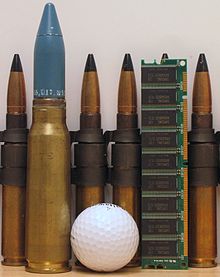20 mm caliber
This article needs additional citations for verification. (April 2011) |
The 20 mm is a specific size of cannon or autocannon ammunition.
Few weapons (aside from shotguns, large game hunting rifles, and heavy caliber muzzleloading "rampart" or "wall guns" popular in the early to mid 19th century European militaries[1]) have been built to fire projectiles between 12.7mm (such as the 12.7mm NATO) and 20 mm, though several 13mm, 14.5mm, and 15mm heavy machine guns were used during World War II, such as the MG 131. The 14.5 mm is still used by some Soviet machine guns, such as the KPV and anti-tank rifles such as PTRS, PTRD, and NTW-20. 15mm was also widely used by the Germans during WWII such as in the MG 151, and the British as well to a lesser extent in the 15mm version of the Besa machine gun, which was used on armored cars and some light tanks.
Since 20mm is the cutoff point where most nations switch from bullets to shells, it has come to also generally be the cutoff point between weapons classified as a machine gun or a cannon. This varies, however. For example, in World War II, Japan classified any weapon over 11 mm as a cannon; thus, in Japanese records, their 12.7 mm Ho-103 aircraft gun is classified as an autocannon, as it used explosive shells to overcome its lower muzzle velocity compared to American 12.7mm/.50BMG weapons. A machine gun does not fire shells, so historically a weapon that fires shells below 20 mm can be a cannon. An accurate description always mentions, in addition to caliber, whether the weapon fires bullets or shells.
A small number of anti-tank rifles were produced in 20 mm and larger calibers.
20 mm cartridges have an outside bullet diameter and inside barrel diameter of 0.787 inches (20.0 mm). Projectiles or bullets are typically 75 to 127 mm (3–5 in) long. Cartridge cases are typically 75 to 152 mm (3–6 in) long. Many but not all 20 mm rounds have an explosive filling and detonating fuze.
As an example, the RT-20 (rifle) fires a 20×110mm 130-gram[2] projectile at a muzzle velocity of 850 m/s.[3] For a simple slug this gives a muzzle energy of 47 kilojoules.
Usage

Like most cannon ammunition, armed forces typically use 20 mm caliber weapons against large targets, such as vehicles, buildings, or aircraft. Though lethal against individual soldiers, 20mm ammunition is so large and heavy that its effects are inefficient against relatively small targets.
Types of ammunition
- High Explosive (HE)
- High Explosive Incendiary (HEI)
- Armour-Piercing (AP)
- Armour Piercing Incendiary (API)
- Armour-Piercing Discarding Sabot (APDS)
- High-Explosive Fragmentary tracer (HEF-t)
- Penetrator with Enhanced Lateral Effect (PELE)
- Target Practice - Inert projectile (i.e., PGU-27A/B).[4] Used for training. (TP)
- Target Practice Tracer - Inert projectile with tracer material in base for visual trajectory tracking (i.e., PGU-30A/B). (TP-T)
20 mm weapons
Each weapon is listed with its cartridge type appended.
Current weapons
- Vidhwansak: 20×82mm
- Anzio 20mm rifle: 20×102mm
- Mk4 20mm cannon: 20×110mmRB Oerlikon 'S'
- HS804 20mm cannon: 20×110mm
- Mk16 20mm cannon: 20×110mm
- RT-20 bolt-action rifle: 20×110mm
- Denel NTW-20: 20×82mm Mauser or 20×110mm Hispano caliber
- M61 Vulcan: 20×102mm (PGU-28/B)
- M197 Gatling gun: 20×102mm
- M39 cannon: 20×102mm
- GIAT M621: 20×102mm
- ZVI PL-20 Plamen: 20x102mm
- Oerlikon KAA & KAB: 20×128mm (formerly the Oerlikon 204GK and 5TG respectively)
- Meroka: 20×128mm
- Oerlikon KAD: 20×139mm (formerly the Hispano-Suiza HS.820)
- GIAT M693/20 mm modèle F2 gun: 20×139mm
- Rheinmetall Rh 202: 20×139mm
- Denel Land Systems GI-2: 20×139mm
Historical weapons
- Becker Type M2 20 mm cannon: 20×70mm RB
- Bofors m/40: 20×145mmR
- Bofors m/45: 20×110mm
- Bofors m/49: 20×110mm
- Berezin B-20 20×99mm
- Breda Model 35 20×138mm B
- Colt Mk 12 cannon: 20×110mm USN (Mk 12 is an advanced derivative of the HS.404)
- Hispano-Suiza HS.404 and derivatives: 20×110mm
- Lahti L-39: 20×138mm B (Solothurn Long)
- Madsen 20 mm anti-aircraft cannon: 20×120mm
- Mauser MG 213: 20×135mm
- MG FF/M cannon: 20×80mm RB
- Mauser MG 151/20: 20×82mm
- Nkm wz.38 FK designated: "Heaviest Machinegun" "Hmg" or "Najcięższy karabin maszynowy, Nkm," AA/AT 20×138mmB autocannon
- Oerlikon FF: 20×72mm RB
- Oerlikon F, FFL: 20×110mm RB
- Polsten: 20x110mm RB
- Rheinmetall FlaK 38: 20×138mm B forerunner of Hispano-Suiza HS.820 post-war 20×139mm round
- Rheinmetall 2 cm KwK 30: 20×138mm B
- Scotti 20 mm: 20x138mm B
- ShVAK: 20×99mmR
- Solothurn S-18/100: 20×105mm B
- Solothurn S-18/1000: 20×138mm B
- Type 97 automatic cannon:20×124mm
- Type 99 cannon : 20×72mmRB (model 1), 20×101mmRB (model 2)
- Ho-5 cannon : 20×94mm
- Ghan-Krnka fortress rifle: 20,3x95R (bullet diameter 21 mm)
Cartridge type indicates the diameter of projectile and the length of the cartridge that holds it; for example 20×102mm is a 20 mm projectile in a 102 mm long case. Only rarely do two designers use the same case length, so this designation is usually definitive. Some cartridge types have additional letters or information about them listed.
See also
References
- ^ Editor. "Big Shots – Amusettes, Jingals And Other Super-Sized Firearms | Militaryhistorynow.com". Retrieved 2016-03-28.
{{cite web}}:|last=has generic name (help) - ^ Williams, A.G. & Gustin, E. (2009): World War 2 fighter armament effectiveness.
- ^ *RT-20 on World Guns.ru Archived 2006-04-27 at the Wayback Machine
- ^ PGU-27A/B TP/ PGU-28A/B SAPHEI / PGU-30A/B TP-T
External links
- FAS: 20 mm Cannon Ammunition
- ATK produced 20, 25 & 30 mm caliber ammunition
- Rapid Fire: 20 mm Cartridge Data Table
- Rapid Fire: 20 mm Antitank Rifle Cartridges image
- Rapid Fire: 20 mm Autocannon Cartridges WWII image 1
- Rapid Fire: 20 mm Autocannon Cartridges WWII image 2
- Rapid Fire: 20 mm Autocannon Cartridges Post-WWII image
